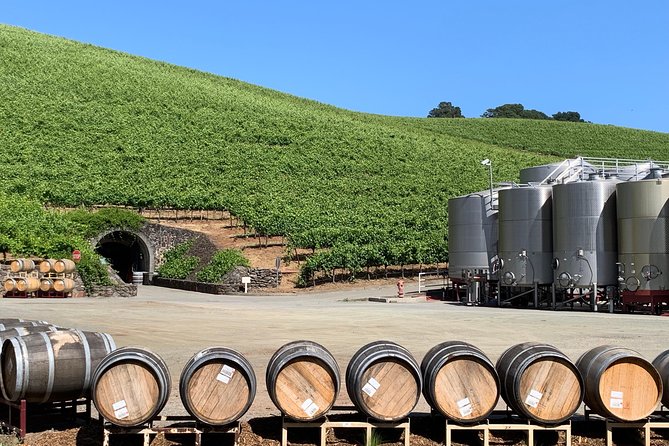Let your guide handle the driving and relax as you sip your way through California’s wine country. After leaving the city of San Francisco in the morning
- Settle into a luxury coach equipped with onboard amenities including reclining seats.
- Hear tales of Spanish missionaries and Gold Rush fortune seekers from your guide as you cruise across the Golden Gate Bridge and through the rolling green hills and pastures of Sonoma Valley.
- Learn about the winemaking process during guided tours of vineyards and barrel rooms, and savor the area’s gourmet culture with a stop for lunch in charming Sonoma Square Plaza.
Wine tour stops
(Pass By) & Quick stop 10 minutes
Napa Valley is famous for being one of the best wine growing regions on the planet. With its countless wineries, a rich history, diverse arts and culture scene and its fantastic gastronomic options, it is also one of California’s tourist hot spots.
The Wappo (Onasatis) became known for beautiful fine-work baskets made of sedge with redbud and bulrush decorations. Feathers, clamshell and abalone beads decorated their gift and ceremonial baskets and the weaving was so precise that baskets were watertight. Women created the finer, more artistic baskets, while men traditionally made rough workbaskets for gathering and fishing from unpeeled willow.
Sonoma County, California is renowned for amazing wines and legendary vineyards, as well as gorgeous organic produce and sustainable farming. Our natural beauty is our calling card, from our mountains, forests, rivers, valleys, and meadows, to all 55 miles of our Pacific Ocean coastline.
History
Sonoma County
Sonoma translates to “Valley of the Moon.” The Pomo, Coast Miwok, and Wappo peoples were the earliest human settlers of Sonoma County, between 8000 and 5000 BC, effectively living within the natural carrying capacity of the land. Spaniards, Russians, and other Europeans and settled in the county from the late 16th to mid-19th century, seeking timber, fur, and farmland.
The first established permanent foothold in Sonoma County was Fort Ross on the coast in 1812. Sonoma was one of the original counties when California became a state in 1850.
ix nations have claimed Sonoma County from 1542 to the present: The Spanish Empire, the Kingdom of England, the Russian Empire, the First Mexican Empire, the Mexican Republic, the California Republic and the United States of America.
Sonoma County is enormous and has an area of 1,768 square miles.
In 1958, Pacific Gas & Electric (PG&E) had rights to land at the head of Bodega Bay and began construction on the first commercial nuclear power plant in the United States in Sonoma County. A landowner and many environmentalists objected, fought, and sank the project which was halted in 1964. The beginnings of this excavation for the nuclear plant is still visible today and aptly named “Hole In The Head.”
As early as 1920, Sonoma County was ranked as the eighth most agriculturally productive US county and a leading producer of hops, grapes, prunes, apples, and dairy and poultry products, largely due to the extent of available, fertile agricultural land in addition to the abundance of high-quality irrigation water.

